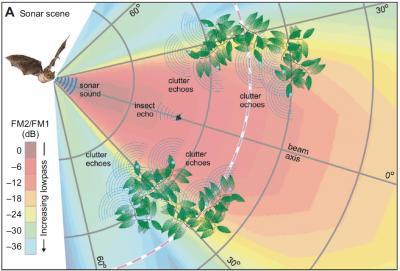How people and animals focus on distinct objects within cluttered scenes is a long-standing neuroscience debate and a great deal of research has looked to the way bats "see" with their ears for answers.
Bats demonstrate remarkable skill in tracking targets such as bugs through the trees in the dark of night. Brown University neuroscience Professor James Simmons, author of a new review paper, would like to figure out how, and point to the "temporal binding hypothesis" as an explanation. This hypothesis proposes that people and animals focus on objects versus the background when a set of neurons in the brain attuned to object features all respond in synchrony, as if shouting in unison "yes, look at that!" When the neurons don't respond together to an object, the hypothesis predicts, an object is relegated to the perceptual background.
Because bats have an especially acute need to track prey through crowded scenes, albeit with echolocation rather than vision, they have evolved to become an ideal testbed for the hypothesis.

Bats send out harmonic pairs of frequencies to sense where things are. The strength differences in the high and low frequencies in the pair (minimal in red, greater in blue) help the bat focus on the target front and center. Credit: James Simmons/Brown University
A Focus of Frequencies
"Sometimes the most critical questions about systems in biology that relate to humans are best approached by using an animal species whose lifestyle requires that the system in question be exaggerated in some functional sense so its qualities are more obvious," said Simmons, who will also discuss the research at the 2014 Cold Spring Harbor Asia Conference in Suzhou, China next month.
Here's how he's determined over the years that temporal binding works in a bat. As the bat flies it emits two spectra of sound frequencies – one high and one low– into a wide cone of space ahead of it. Within the spectra are harmonic pairs of high and low frequencies, for example 33 kilohertz and 66 kilohertz. These harmonic pairs reflect off of objects and back to the bat's ears, triggering a response from neurons in its brain. Objects that reflect these harmonic pairs back in perfect synchrony are the ones that stand out clearly for the bat.
Of course it's more complicated than just that. Many things could reflect the same frequency pairs back at the same time. The real question is how a target object would stand out. The answer, Simmons writes, comes from the physics of the echolocation sound waves and how bat brains have evolved to process their signal. Those factors conspire to ensure that whatever the bat keeps front-and-center in its echolocation cone will stand out from surrounding interference.
The higher frequency sounds in the bat's spectrum weaken in transit through the air more than lower frequency sounds. The bat also sends out the lower frequencies to a wider span of angles than the high frequencies. So For any given harmonic pair, the farther away or more peripheral a reflecting object is, the weaker the higher frequency reflection in the harmonic pair will be. In the brain, Simmons writes, the bat converts this difference in signal strength into a delay in time (about 15 microseconds per decibel) so that harmonic pairs with wide differences in signal strength end up being perceived as way out of synchrony in time. The temporal binding hypothesis, predicts that the distant or peripheral objects with these out-of-synch signals will be perceived as the background while front-and-center objects that reflect back both harmonics with equal strength will rise above their desynchronized competitors.
With support from sources including the U.S. Navy, Simmons's research group has experimentally verified this. In key experiments (some dating back 40 years) they've sat big brown bats at the base of a Y-shaped platform with a pair of objects – one a target with a food reward and the other a distractor – on the tines of the Y. When the objects are at different distances, the bat can tell them apart and accurately crawl to the target. When the objects are equidistant, the bat becomes confused. Crucially, when the experimenters artificially weaken the high-pitched harmonic from the distracting object, even when it remains equidistant, the bat's acumen to find the target is restored.
In further experiments in 2010 and 2011, Simmons' team showed that if they shifted the distractor object's weakened high frequency signal by the right amount of time (remember: 15 microseconds per decibel) they could restore the distractor's ability to interfere with the target object by restoring the synchrony of the distractor's harmonics. In other words, they used the specific predictions of the hypothesis and their understanding of how it works in bats to jam the bat's echolocation ability.
If targeting and jamming sound like words associated with radar and sonar, that's no coincidence. Simmons works with the U.S. Navy on applications of bat echolocation to navigation technology. He recently began a new research grant from the Office of Naval Research that involves bat sonar work in collaboration with researcher Jason Gaudette at the Naval Undersea Warfare Center in Newport, R.I.
Simmons said he believes the evidence he's gathered about the neuroscience of bats not only supports the temporal binding hypothesis, but also can inspire new technology.
"This is a better way to design a radar or sonar system if you need it to perform well in real-time for a small vehicle in complicated tasks," he said.
Source: Brown University




Comments